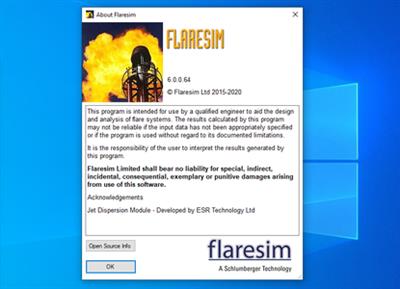Schlumberger Flaresim 6.0.0.64 | 209 MB
Flaresim is the industry standard flare simulation/design application. Designed by professional engineers, for professional engineers, it models thermal radiation and noise footprints generated by flare systems for offshore platforms, gas plants, refineries and chemical plants, and predicts the temperature of exposed surfaces within range.
The application can analyze installations of any complexity, with unlimited multiple flare tips on multiple vertical, horizontal or inclined flare stacks. Users can model pipe flares, sonic flares and liquid burners using a range of algorithms. They can also enter and report data in units of their choice, and can convert data to other units at any time.
Flaresim provides full 3D flame-shape analysis with complete flexibility in the location and orientation of multiple stacks, and rapid evaluation of flare systems under different wind speeds and directions. Shield options can be included.
Working from the opposite perspective, Flaresim allows you to design stack or boom length to meet specific radiation, noise or surface-temperature limits at defined receptor points.
Flaresim includes gas dispersion models for both jet dispersion of flammable gases close to the stack and Gaussian dispersion of pollutants at longer distances.
The output from Flaresim is highly customizable, and you can select either summary or detailed output. Flaresim has a user-friendly interface and incorporates context-sensitive help at every stage for user guidance.
Features OverviewEqually applicable to the design of flare systems for offshore platforms, gas plants, refineries and chemical plants.Data may be entered and reported in the users choice of units and may be converted at any time.Correlations are available for modelling a range of flare tips including sonic tips, pipeflare tips and steam or air assisted tips. For assisted flares the quantity of steam or air required for smokeless operation can be calculated.A number of correlations are provided to predict the fraction of heat radiated from flames of a range of hydrocarbon fluids with different types of flare tip.Liquid flaring systems can be handled.A wide range of algorithms for calculation of thermal radiation. These include the McMurray integrated multipoint methods and the Chamberlain (Shell) method in addition to the Hajek/Ludwig and Brzustowski/Sommer methods which are described in the API 521 guidelines for flare system design.Full three dimensional flame shape analysis with complete flexibility in specification of the location and orientation of multiple stacks.Thermodynamic flash routines from NIST to calculate change in fluid properties with pressure.Dynamic calculation option to evaluate results as flare flows vary with time.Calculation of thermal radiation dose received over a period of time.Case study manager to allow multiple comparitive results to be generated within a single Flaresim model.Calculation of combustion gas composition.Calculation of purge gas flows required for tips.Jet dispersion model to analyse flammable gas concentrations close to flare in flame out conditions.Gaussian dispersion model to analyse longer distance dispersion of the relieving fluid or combustion gases.A range of options for defining and analysing the noise spectrum generated by flare systems including user defined spectra.Ability to define multiple environmental scenarios to allow rapid evaluation of flare system performance under different wind speeds and directions.Multiple stacks/booms each accommodating multiple flare tips.Calculation of radiation, noise spectrum and surface temperatures at multiple receptor points.Calculation of radiation variation with wind direction and speed at a point and display of results on a wind rose chart.Ability to define multiple receptor grids in multiple planes for calculation of radiation, noise or surface temperatures.Descriptionting of grid results as isopleth contours for sterile area definition.Receptor point characteristics for calculating surface temperatures include mass, absorptivity, emissivity, area, specific heat, orientation and initial temperature.Option to define local environmental conditions at receptor points for calculating temperatures.Sizing and rating of knock out drums.Sizing and rating of seal drumsModelling of water curtains or solid shields to reduce radiation and noise transmission.Sizing of stack or boom length to meet radiation, noise or surface temperature limits at defined receptor points.Sterile area calculations to allow the safe distance from flare stack at different radiation limits.A setup wizard to allow new users to set up an initial model rapidly with appropriate defaults.Graphical overlay setup wizard to allow rapid integration of Description plans with isopleth results.Expert mode to control access to less commonly used options.Import of files from Flaresim 2.0 and later.Multiple reports can be created and compared as updates are made to a model and the data corresponding to any report can be saved.Quality Assurance options are included in the reports.Customisable HTML reportsCustomisable graphic reportsMultiple Flaresim cases can be open at the same time.

Download link:
Só visivel para registados e com resposta ao tópico.Only visible to registered and with a reply to the topic.Links are Interchangeable - No Password - Single Extraction

